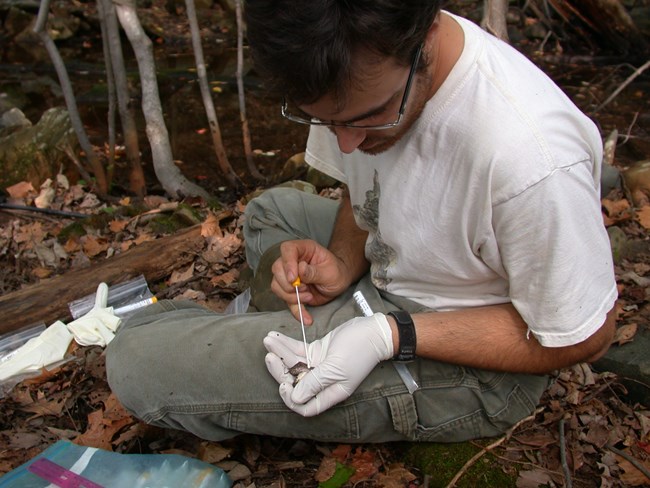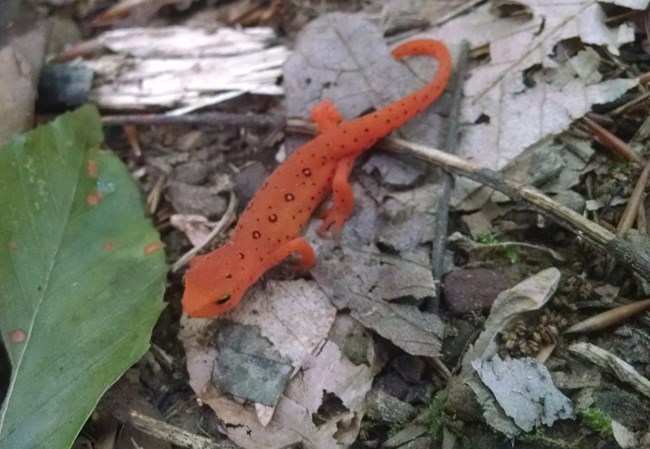Last updated: April 12, 2022
Article
Amphibian Disease Risk in the National Capital Area

Grant/USGS
By Evan Grant, Research Wildlife Biologist with the U.S. Geological Survey and collaborator with the NPS National Capital Region Inventory & Monitoring Network
Spring weather brought rains to fill dry wetland basins and the gathering of many salamanders, frogs and toads at wetlands to breed. Following breeding, larvae race to metamorphose before ponds dry as trees respire water and the summer sun evaporates surface water. For some species, this season also brings the risk of disease outbreaks before individuals disperse into the forests to forage and overwinter. Breeding pools can create ideal habitats for disease to spread, with their warmer temperatures, many individuals packed into a small area, and amphibians already-stressed by competition or limited food.
To gauge this disease risk, amphibian monitoring in National Capital Region (NCR) parks includes disease sampling, and collaborating scientists from the USGS Northeast Amphibian Research and Monitoring Initiative (NEARMI) are always on the lookout for signs of disease. Two main groups of pathogens have been the focus of disease sampling in the NCR: Ranaviruses and chytrid fungi.
Ranavirus
Ranaviruses can infect insects, fish, and amphibians, but are not known to infect warm-blooded animals. Signs of ranavirus include a massive number of sick and dead amphibians (particularly larvae) at an affected wetland. Sick individuals usually show small skin ulcers and reddened, swollen skin along the stomach and base of the limbs. Most amphibian dieoffs detected in the region have been attributed to Ranavirus.
Chytrid
There are two chytrid fungi known to infect the skin of amphibians and cause chytridiomycosis: Batrachochytrium dendrobatidis (Bd) and Batrachochytrium salamandrivorans (Bsal). While Bd has been linked to dramatic declines or extinctions of amphibians in other regions of the U.S., no chytridiomycosis or dieoffs due to this pathogen have been documented in NCR park amphibians. Bd is present and regularly detected on skin swabs of healthy amphibians during routine disease monitoring but at present there isn’t evidence that this is affecting populations. There are several potential explanations; they may be able to recover from infection or they may have the pathogen on their skin but may avoid getting infected.

Brolis/NPS
The Bsal pathogen has not yet been found in any wild amphibian populations in the U.S. However, laboratory results suggest it has the potential to cause declines of some species in NCR parks (for example, eastern red-spotted newts) if it is introduced. USGS scientists with NEARMI are working with multiple protected area managers in the Northeast to predict the effectiveness of management actions to combat Bsal if the pathogen is introduced. Outcomes of this work could give NCR parks a headstart on fighting Bsal.
Preventing Disease Spread
When monitoring NCR park amphibian communities, USGS follows biosecurity protocols to reduce the risk of carrying disease accidentally between habitats. These protocols should be used by anyone working in and around amphibian habitat, including wetlands, breeding sites, or upland areas used by amphibians. In general, the protocols recommend disinfecting all equipment, including but not limited to, waders, boots, nets, and calipers in a > 10% bleach solution between sites.
Reporting observations of disease
We encourage anyone who sees an amphibian disease outbreak or die-off to report this to the USGS National Wildlife Health Center or their local wildlife department. We also encourage all wetland surveyors to practice sterile techniques to help protect local amphibian populations.
Tags
- antietam national battlefield
- catoctin mountain park
- chesapeake & ohio canal national historical park
- george washington memorial parkway
- harpers ferry national historical park
- manassas national battlefield park
- monocacy national battlefield
- national capital parks-east
- piscataway park
- prince william forest park
- rock creek park
- wolf trap national park for the performing arts
- amphibians
- disease
- ranavirus
- chytrid fungus
- ncrn
- inventory & monitoring
- i&m
- amphibian monitoring
- natural resource quarterly
- fall 2020
